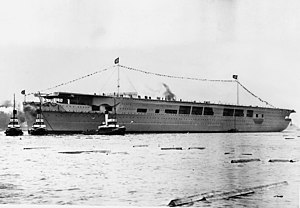Graf Zeppelin-class aircraft carrier

Aircraft carrier Graf Zeppelin
|
|
| Class overview | |
|---|---|
| Builders: | Friedrich Krupp Germaniawerft, Deutsche Werke |
| Planned: | 2 (originally 4) |
| Completed: | 0 |
| Cancelled: | 2 |
| General characteristics | |
| Displacement: | 33,550 tonnes |
| Length: | 262.5 m (861 ft 3 in) |
| Beam: | 31.5 m (103 ft 4 in) |
| Draft: | 7.6 m (24 ft 11 in) |
| Propulsion: | Geared turbines, 200,000 hp (150,000 kW), four screws |
| Speed: | 35 knots (65 km/h) |
| Range: | 14,816 km (8,000 nmi) at 19 knots (35 km/h) |
| Complement: |
|
| Armament: |
|
| Aircraft carried: |
|
The Graf Zeppelin-class aircraft carriers were four German Kriegsmarine aircraft carriers planned in the mid-1930s by Grand Admiral Erich Raeder as part of the Plan Z rearmament program after Germany and Great Britain signed the Anglo-German Naval Agreement. They were planned after a thorough study of Japanese carrier designs; nevertheless, German naval architects ran into difficulties due to lack of experience in building such vessels, the situational realities of carrier operations in the North Sea and the lack of overall clarity in the ships' mission objectives. This lack of clarity led to features such as cruiser-type guns for commerce raiding and defense against British cruisers, that were either eliminated from or not included in American and Japanese carrier designs. American and Japanese carriers, designed along the lines of task-force defense, used supporting cruisers for surface firepower, which allowed flight operations to continue without disruption and kept carriers out of undue risk of damage or sinking from surface action.
A combination of political infighting between the Kriegsmarine and the Luftwaffe, disputes within the ranks of the Kriegsmarine itself and Adolf Hitler's waning interest all conspired against the carriers. A shortage of workers and materials slowed construction still further and, in 1939, Raeder reduced the number of ships from four to two. Even so, the Luftwaffe trained its first unit of pilots for carrier service and readied it for flight operations. With the advent of World War II, priorities shifted to U-boat construction; one carrier, Flugzeugträger B, was broken up on the slipway while work on the other, Flugzeugträger A (christened Graf Zeppelin) was continued tentatively but suspended in 1940. The air unit scheduled for her was disbanded at that time.
The role of aircraft in the Battle of Taranto, the pursuit of the German battleship Bismarck, the attack on Pearl Harbor and the Battle of Midway demonstrated conclusively the usefulness of aircraft carriers in modern naval warfare. With Hitler's authorization, work resumed on the remaining carrier. Progress was again delayed, this time by the demand for newer planes specifically designed for carrier use and the need for modernizing the ship in light of wartime developments. Hitler's disenchantment with the performance of the Kriegsmarine's surface units led to a final stoppage of work. The ship was captured by the Soviet Union at the end of the war and sunk as a target ship in 1947.
...
Wikipedia
